Evaluating National Culture Convergence and HRM Strategies
VerifiedAdded on 2022/09/11
|11
|3027
|19
Essay
AI Summary
This essay critically evaluates the convergence or divergence of national cultures in the contemporary business world, focusing on its implications for multinational corporations (MNCs) and their International Human Resource Management (IHRM) strategies and practices. The essay explores the increasing internationalization of businesses, the formation of trade partnerships, and the resulting convergence of business cultures. It discusses Hofstede's cultural dimensions and their relevance in the context of cultural convergence, highlighting the benefits of convergence such as creating unity, fostering communication, and improving supply chain efficiency. Furthermore, the essay examines how national culture convergence influences key IHRM practices, including employee selection, career planning, training and development, and performance appraisal and compensation. The analysis draws on academic literature and provides examples, such as the case of Tesla, to illustrate the concepts discussed.
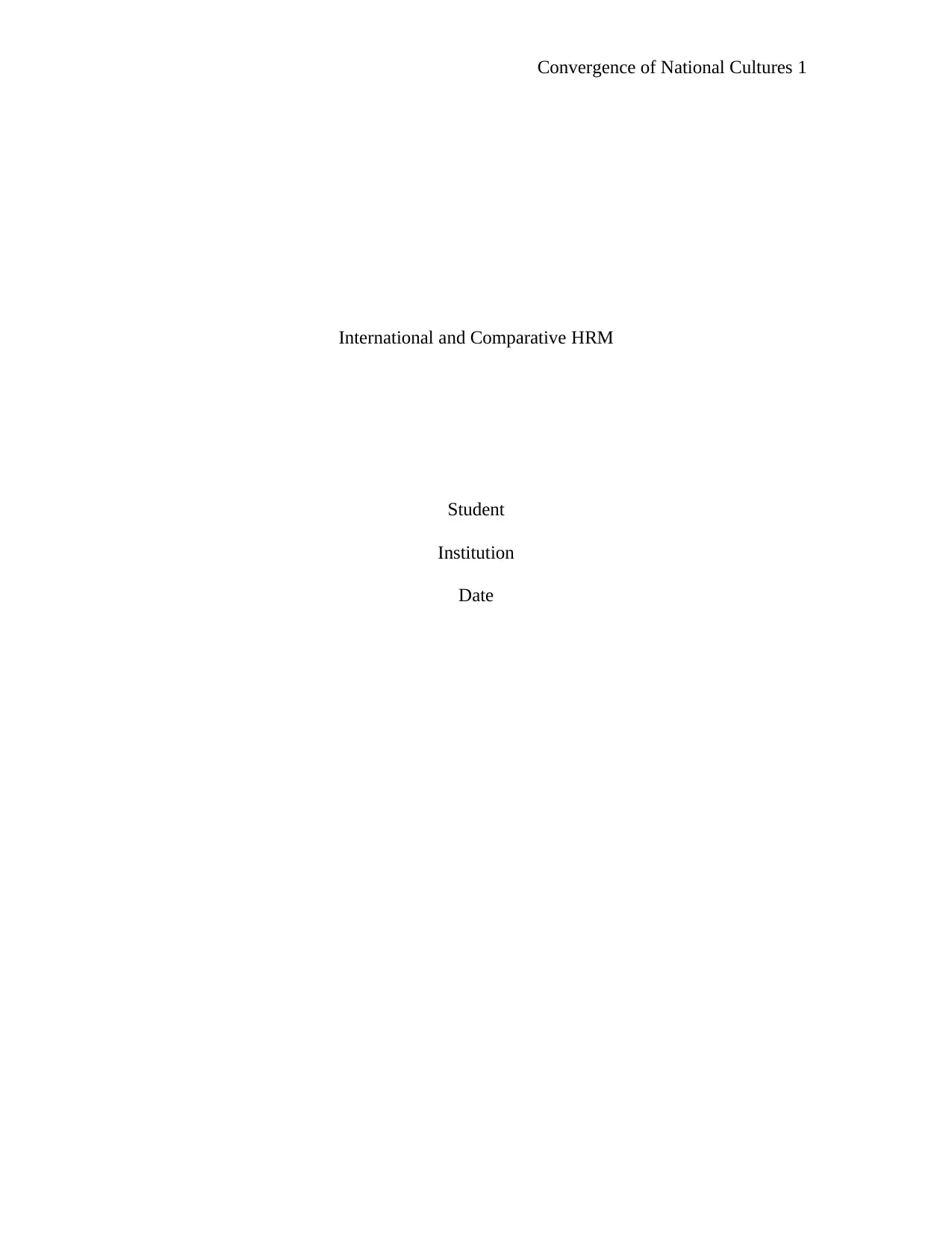
Convergence of National Cultures 1
International and Comparative HRM
Student
Institution
Date
International and Comparative HRM
Student
Institution
Date
Paraphrase This Document
Need a fresh take? Get an instant paraphrase of this document with our AI Paraphraser
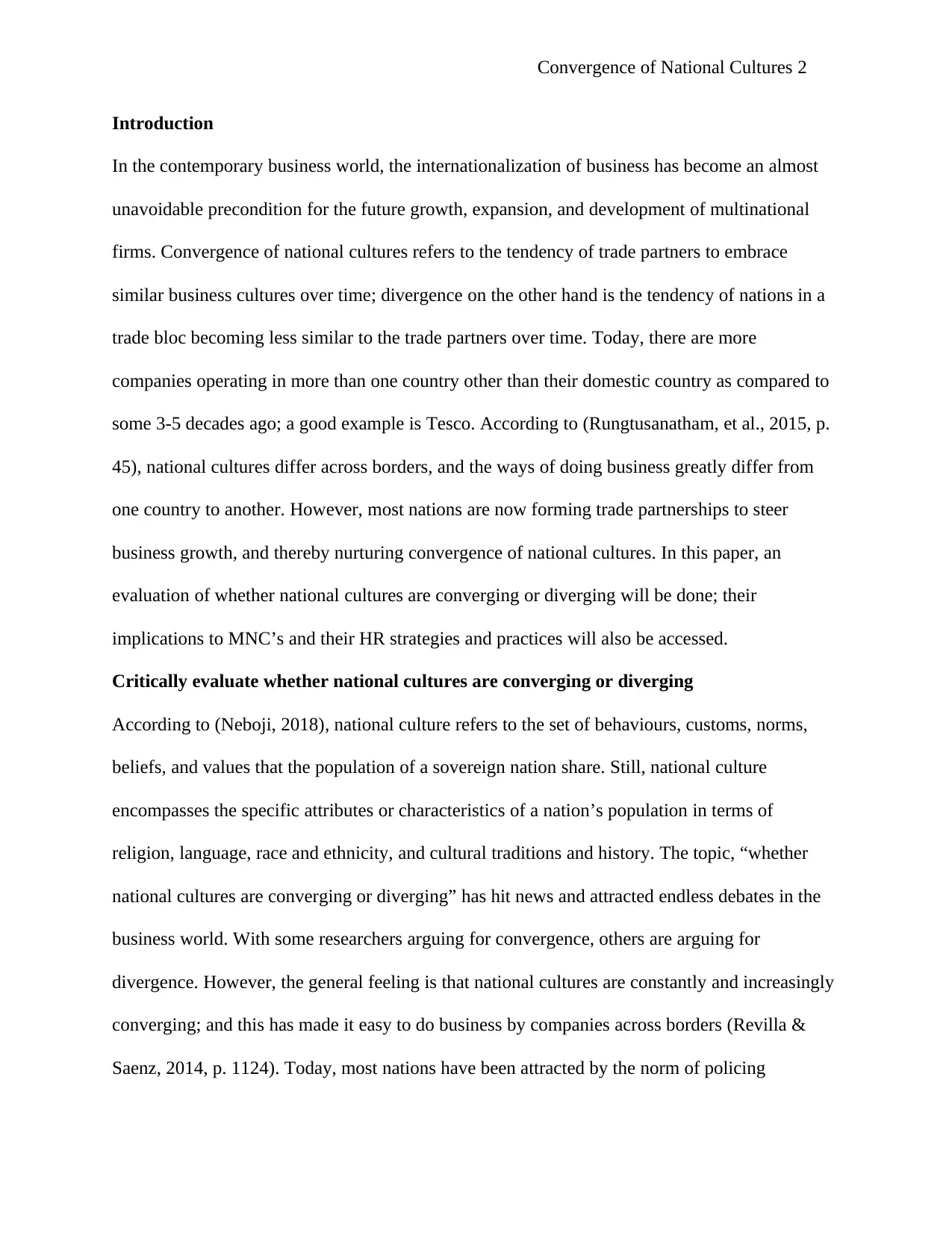
Convergence of National Cultures 2
Introduction
In the contemporary business world, the internationalization of business has become an almost
unavoidable precondition for the future growth, expansion, and development of multinational
firms. Convergence of national cultures refers to the tendency of trade partners to embrace
similar business cultures over time; divergence on the other hand is the tendency of nations in a
trade bloc becoming less similar to the trade partners over time. Today, there are more
companies operating in more than one country other than their domestic country as compared to
some 3-5 decades ago; a good example is Tesco. According to (Rungtusanatham, et al., 2015, p.
45), national cultures differ across borders, and the ways of doing business greatly differ from
one country to another. However, most nations are now forming trade partnerships to steer
business growth, and thereby nurturing convergence of national cultures. In this paper, an
evaluation of whether national cultures are converging or diverging will be done; their
implications to MNC’s and their HR strategies and practices will also be accessed.
Critically evaluate whether national cultures are converging or diverging
According to (Neboji, 2018), national culture refers to the set of behaviours, customs, norms,
beliefs, and values that the population of a sovereign nation share. Still, national culture
encompasses the specific attributes or characteristics of a nation’s population in terms of
religion, language, race and ethnicity, and cultural traditions and history. The topic, “whether
national cultures are converging or diverging” has hit news and attracted endless debates in the
business world. With some researchers arguing for convergence, others are arguing for
divergence. However, the general feeling is that national cultures are constantly and increasingly
converging; and this has made it easy to do business by companies across borders (Revilla &
Saenz, 2014, p. 1124). Today, most nations have been attracted by the norm of policing
Introduction
In the contemporary business world, the internationalization of business has become an almost
unavoidable precondition for the future growth, expansion, and development of multinational
firms. Convergence of national cultures refers to the tendency of trade partners to embrace
similar business cultures over time; divergence on the other hand is the tendency of nations in a
trade bloc becoming less similar to the trade partners over time. Today, there are more
companies operating in more than one country other than their domestic country as compared to
some 3-5 decades ago; a good example is Tesco. According to (Rungtusanatham, et al., 2015, p.
45), national cultures differ across borders, and the ways of doing business greatly differ from
one country to another. However, most nations are now forming trade partnerships to steer
business growth, and thereby nurturing convergence of national cultures. In this paper, an
evaluation of whether national cultures are converging or diverging will be done; their
implications to MNC’s and their HR strategies and practices will also be accessed.
Critically evaluate whether national cultures are converging or diverging
According to (Neboji, 2018), national culture refers to the set of behaviours, customs, norms,
beliefs, and values that the population of a sovereign nation share. Still, national culture
encompasses the specific attributes or characteristics of a nation’s population in terms of
religion, language, race and ethnicity, and cultural traditions and history. The topic, “whether
national cultures are converging or diverging” has hit news and attracted endless debates in the
business world. With some researchers arguing for convergence, others are arguing for
divergence. However, the general feeling is that national cultures are constantly and increasingly
converging; and this has made it easy to do business by companies across borders (Revilla &
Saenz, 2014, p. 1124). Today, most nations have been attracted by the norm of policing
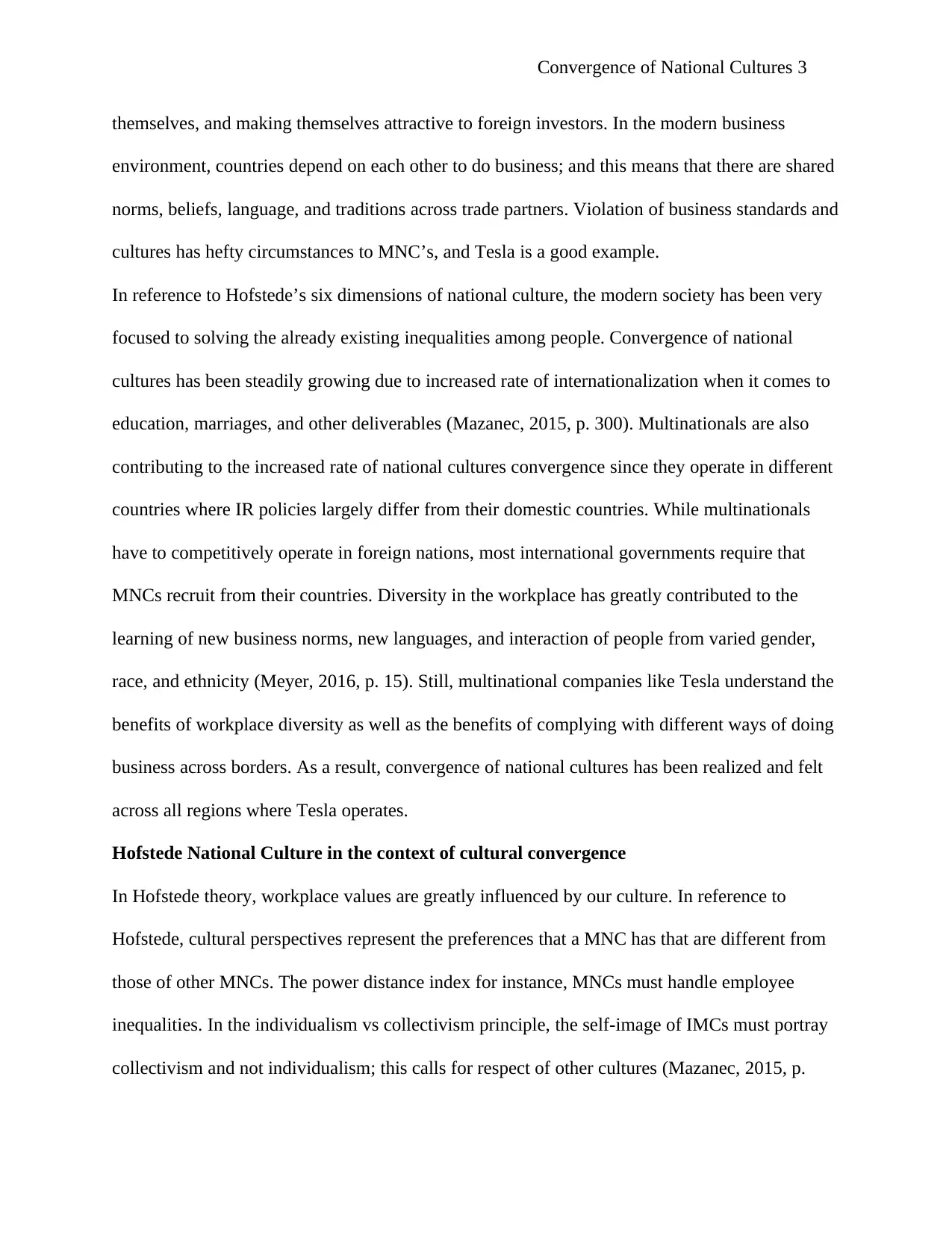
Convergence of National Cultures 3
themselves, and making themselves attractive to foreign investors. In the modern business
environment, countries depend on each other to do business; and this means that there are shared
norms, beliefs, language, and traditions across trade partners. Violation of business standards and
cultures has hefty circumstances to MNC’s, and Tesla is a good example.
In reference to Hofstede’s six dimensions of national culture, the modern society has been very
focused to solving the already existing inequalities among people. Convergence of national
cultures has been steadily growing due to increased rate of internationalization when it comes to
education, marriages, and other deliverables (Mazanec, 2015, p. 300). Multinationals are also
contributing to the increased rate of national cultures convergence since they operate in different
countries where IR policies largely differ from their domestic countries. While multinationals
have to competitively operate in foreign nations, most international governments require that
MNCs recruit from their countries. Diversity in the workplace has greatly contributed to the
learning of new business norms, new languages, and interaction of people from varied gender,
race, and ethnicity (Meyer, 2016, p. 15). Still, multinational companies like Tesla understand the
benefits of workplace diversity as well as the benefits of complying with different ways of doing
business across borders. As a result, convergence of national cultures has been realized and felt
across all regions where Tesla operates.
Hofstede National Culture in the context of cultural convergence
In Hofstede theory, workplace values are greatly influenced by our culture. In reference to
Hofstede, cultural perspectives represent the preferences that a MNC has that are different from
those of other MNCs. The power distance index for instance, MNCs must handle employee
inequalities. In the individualism vs collectivism principle, the self-image of IMCs must portray
collectivism and not individualism; this calls for respect of other cultures (Mazanec, 2015, p.
themselves, and making themselves attractive to foreign investors. In the modern business
environment, countries depend on each other to do business; and this means that there are shared
norms, beliefs, language, and traditions across trade partners. Violation of business standards and
cultures has hefty circumstances to MNC’s, and Tesla is a good example.
In reference to Hofstede’s six dimensions of national culture, the modern society has been very
focused to solving the already existing inequalities among people. Convergence of national
cultures has been steadily growing due to increased rate of internationalization when it comes to
education, marriages, and other deliverables (Mazanec, 2015, p. 300). Multinationals are also
contributing to the increased rate of national cultures convergence since they operate in different
countries where IR policies largely differ from their domestic countries. While multinationals
have to competitively operate in foreign nations, most international governments require that
MNCs recruit from their countries. Diversity in the workplace has greatly contributed to the
learning of new business norms, new languages, and interaction of people from varied gender,
race, and ethnicity (Meyer, 2016, p. 15). Still, multinational companies like Tesla understand the
benefits of workplace diversity as well as the benefits of complying with different ways of doing
business across borders. As a result, convergence of national cultures has been realized and felt
across all regions where Tesla operates.
Hofstede National Culture in the context of cultural convergence
In Hofstede theory, workplace values are greatly influenced by our culture. In reference to
Hofstede, cultural perspectives represent the preferences that a MNC has that are different from
those of other MNCs. The power distance index for instance, MNCs must handle employee
inequalities. In the individualism vs collectivism principle, the self-image of IMCs must portray
collectivism and not individualism; this calls for respect of other cultures (Mazanec, 2015, p.
⊘ This is a preview!⊘
Do you want full access?
Subscribe today to unlock all pages.

Trusted by 1+ million students worldwide
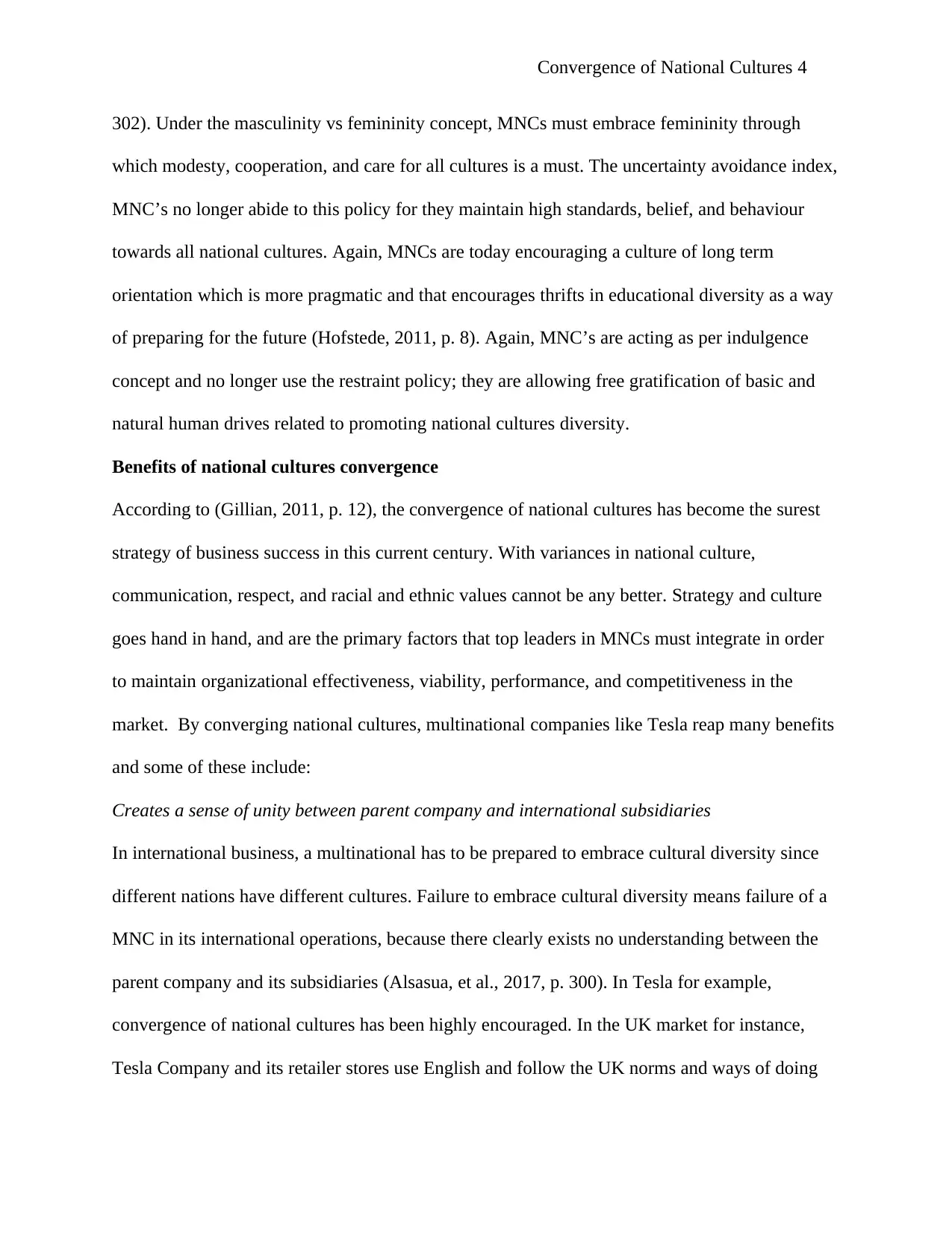
Convergence of National Cultures 4
302). Under the masculinity vs femininity concept, MNCs must embrace femininity through
which modesty, cooperation, and care for all cultures is a must. The uncertainty avoidance index,
MNC’s no longer abide to this policy for they maintain high standards, belief, and behaviour
towards all national cultures. Again, MNCs are today encouraging a culture of long term
orientation which is more pragmatic and that encourages thrifts in educational diversity as a way
of preparing for the future (Hofstede, 2011, p. 8). Again, MNC’s are acting as per indulgence
concept and no longer use the restraint policy; they are allowing free gratification of basic and
natural human drives related to promoting national cultures diversity.
Benefits of national cultures convergence
According to (Gillian, 2011, p. 12), the convergence of national cultures has become the surest
strategy of business success in this current century. With variances in national culture,
communication, respect, and racial and ethnic values cannot be any better. Strategy and culture
goes hand in hand, and are the primary factors that top leaders in MNCs must integrate in order
to maintain organizational effectiveness, viability, performance, and competitiveness in the
market. By converging national cultures, multinational companies like Tesla reap many benefits
and some of these include:
Creates a sense of unity between parent company and international subsidiaries
In international business, a multinational has to be prepared to embrace cultural diversity since
different nations have different cultures. Failure to embrace cultural diversity means failure of a
MNC in its international operations, because there clearly exists no understanding between the
parent company and its subsidiaries (Alsasua, et al., 2017, p. 300). In Tesla for example,
convergence of national cultures has been highly encouraged. In the UK market for instance,
Tesla Company and its retailer stores use English and follow the UK norms and ways of doing
302). Under the masculinity vs femininity concept, MNCs must embrace femininity through
which modesty, cooperation, and care for all cultures is a must. The uncertainty avoidance index,
MNC’s no longer abide to this policy for they maintain high standards, belief, and behaviour
towards all national cultures. Again, MNCs are today encouraging a culture of long term
orientation which is more pragmatic and that encourages thrifts in educational diversity as a way
of preparing for the future (Hofstede, 2011, p. 8). Again, MNC’s are acting as per indulgence
concept and no longer use the restraint policy; they are allowing free gratification of basic and
natural human drives related to promoting national cultures diversity.
Benefits of national cultures convergence
According to (Gillian, 2011, p. 12), the convergence of national cultures has become the surest
strategy of business success in this current century. With variances in national culture,
communication, respect, and racial and ethnic values cannot be any better. Strategy and culture
goes hand in hand, and are the primary factors that top leaders in MNCs must integrate in order
to maintain organizational effectiveness, viability, performance, and competitiveness in the
market. By converging national cultures, multinational companies like Tesla reap many benefits
and some of these include:
Creates a sense of unity between parent company and international subsidiaries
In international business, a multinational has to be prepared to embrace cultural diversity since
different nations have different cultures. Failure to embrace cultural diversity means failure of a
MNC in its international operations, because there clearly exists no understanding between the
parent company and its subsidiaries (Alsasua, et al., 2017, p. 300). In Tesla for example,
convergence of national cultures has been highly encouraged. In the UK market for instance,
Tesla Company and its retailer stores use English and follow the UK norms and ways of doing
Paraphrase This Document
Need a fresh take? Get an instant paraphrase of this document with our AI Paraphraser
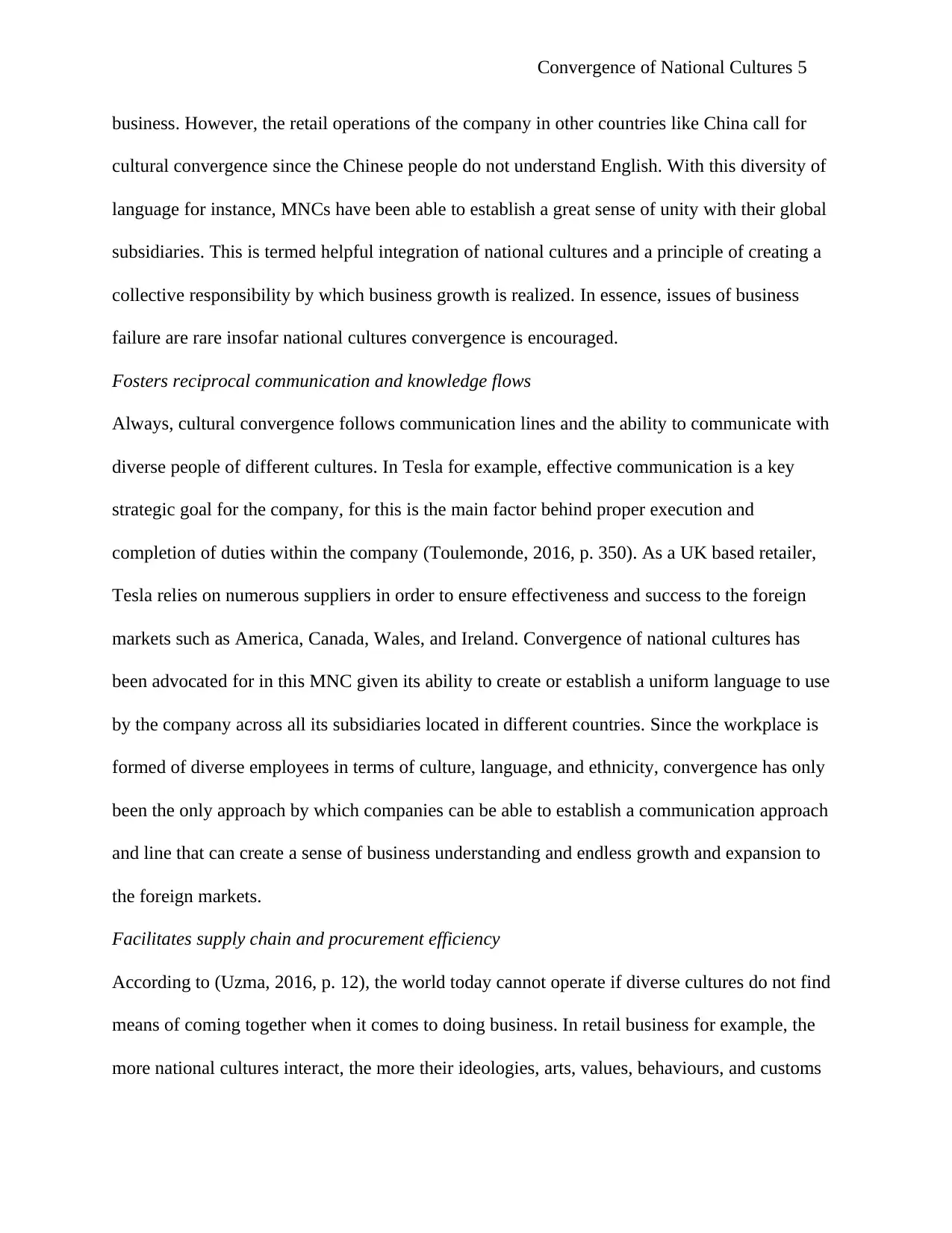
Convergence of National Cultures 5
business. However, the retail operations of the company in other countries like China call for
cultural convergence since the Chinese people do not understand English. With this diversity of
language for instance, MNCs have been able to establish a great sense of unity with their global
subsidiaries. This is termed helpful integration of national cultures and a principle of creating a
collective responsibility by which business growth is realized. In essence, issues of business
failure are rare insofar national cultures convergence is encouraged.
Fosters reciprocal communication and knowledge flows
Always, cultural convergence follows communication lines and the ability to communicate with
diverse people of different cultures. In Tesla for example, effective communication is a key
strategic goal for the company, for this is the main factor behind proper execution and
completion of duties within the company (Toulemonde, 2016, p. 350). As a UK based retailer,
Tesla relies on numerous suppliers in order to ensure effectiveness and success to the foreign
markets such as America, Canada, Wales, and Ireland. Convergence of national cultures has
been advocated for in this MNC given its ability to create or establish a uniform language to use
by the company across all its subsidiaries located in different countries. Since the workplace is
formed of diverse employees in terms of culture, language, and ethnicity, convergence has only
been the only approach by which companies can be able to establish a communication approach
and line that can create a sense of business understanding and endless growth and expansion to
the foreign markets.
Facilitates supply chain and procurement efficiency
According to (Uzma, 2016, p. 12), the world today cannot operate if diverse cultures do not find
means of coming together when it comes to doing business. In retail business for example, the
more national cultures interact, the more their ideologies, arts, values, behaviours, and customs
business. However, the retail operations of the company in other countries like China call for
cultural convergence since the Chinese people do not understand English. With this diversity of
language for instance, MNCs have been able to establish a great sense of unity with their global
subsidiaries. This is termed helpful integration of national cultures and a principle of creating a
collective responsibility by which business growth is realized. In essence, issues of business
failure are rare insofar national cultures convergence is encouraged.
Fosters reciprocal communication and knowledge flows
Always, cultural convergence follows communication lines and the ability to communicate with
diverse people of different cultures. In Tesla for example, effective communication is a key
strategic goal for the company, for this is the main factor behind proper execution and
completion of duties within the company (Toulemonde, 2016, p. 350). As a UK based retailer,
Tesla relies on numerous suppliers in order to ensure effectiveness and success to the foreign
markets such as America, Canada, Wales, and Ireland. Convergence of national cultures has
been advocated for in this MNC given its ability to create or establish a uniform language to use
by the company across all its subsidiaries located in different countries. Since the workplace is
formed of diverse employees in terms of culture, language, and ethnicity, convergence has only
been the only approach by which companies can be able to establish a communication approach
and line that can create a sense of business understanding and endless growth and expansion to
the foreign markets.
Facilitates supply chain and procurement efficiency
According to (Uzma, 2016, p. 12), the world today cannot operate if diverse cultures do not find
means of coming together when it comes to doing business. In retail business for example, the
more national cultures interact, the more their ideologies, arts, values, behaviours, and customs
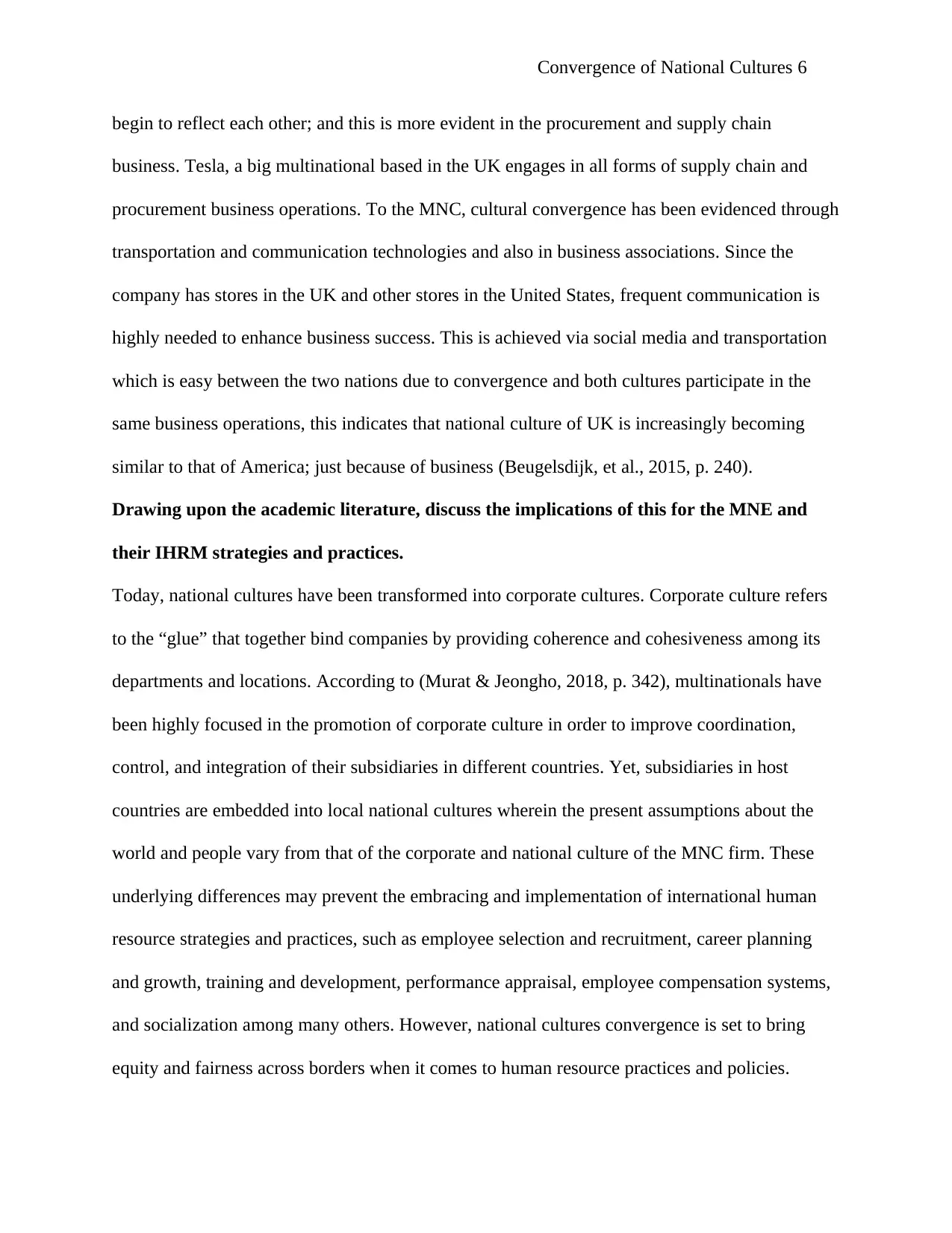
Convergence of National Cultures 6
begin to reflect each other; and this is more evident in the procurement and supply chain
business. Tesla, a big multinational based in the UK engages in all forms of supply chain and
procurement business operations. To the MNC, cultural convergence has been evidenced through
transportation and communication technologies and also in business associations. Since the
company has stores in the UK and other stores in the United States, frequent communication is
highly needed to enhance business success. This is achieved via social media and transportation
which is easy between the two nations due to convergence and both cultures participate in the
same business operations, this indicates that national culture of UK is increasingly becoming
similar to that of America; just because of business (Beugelsdijk, et al., 2015, p. 240).
Drawing upon the academic literature, discuss the implications of this for the MNE and
their IHRM strategies and practices.
Today, national cultures have been transformed into corporate cultures. Corporate culture refers
to the “glue” that together bind companies by providing coherence and cohesiveness among its
departments and locations. According to (Murat & Jeongho, 2018, p. 342), multinationals have
been highly focused in the promotion of corporate culture in order to improve coordination,
control, and integration of their subsidiaries in different countries. Yet, subsidiaries in host
countries are embedded into local national cultures wherein the present assumptions about the
world and people vary from that of the corporate and national culture of the MNC firm. These
underlying differences may prevent the embracing and implementation of international human
resource strategies and practices, such as employee selection and recruitment, career planning
and growth, training and development, performance appraisal, employee compensation systems,
and socialization among many others. However, national cultures convergence is set to bring
equity and fairness across borders when it comes to human resource practices and policies.
begin to reflect each other; and this is more evident in the procurement and supply chain
business. Tesla, a big multinational based in the UK engages in all forms of supply chain and
procurement business operations. To the MNC, cultural convergence has been evidenced through
transportation and communication technologies and also in business associations. Since the
company has stores in the UK and other stores in the United States, frequent communication is
highly needed to enhance business success. This is achieved via social media and transportation
which is easy between the two nations due to convergence and both cultures participate in the
same business operations, this indicates that national culture of UK is increasingly becoming
similar to that of America; just because of business (Beugelsdijk, et al., 2015, p. 240).
Drawing upon the academic literature, discuss the implications of this for the MNE and
their IHRM strategies and practices.
Today, national cultures have been transformed into corporate cultures. Corporate culture refers
to the “glue” that together bind companies by providing coherence and cohesiveness among its
departments and locations. According to (Murat & Jeongho, 2018, p. 342), multinationals have
been highly focused in the promotion of corporate culture in order to improve coordination,
control, and integration of their subsidiaries in different countries. Yet, subsidiaries in host
countries are embedded into local national cultures wherein the present assumptions about the
world and people vary from that of the corporate and national culture of the MNC firm. These
underlying differences may prevent the embracing and implementation of international human
resource strategies and practices, such as employee selection and recruitment, career planning
and growth, training and development, performance appraisal, employee compensation systems,
and socialization among many others. However, national cultures convergence is set to bring
equity and fairness across borders when it comes to human resource practices and policies.
⊘ This is a preview!⊘
Do you want full access?
Subscribe today to unlock all pages.

Trusted by 1+ million students worldwide
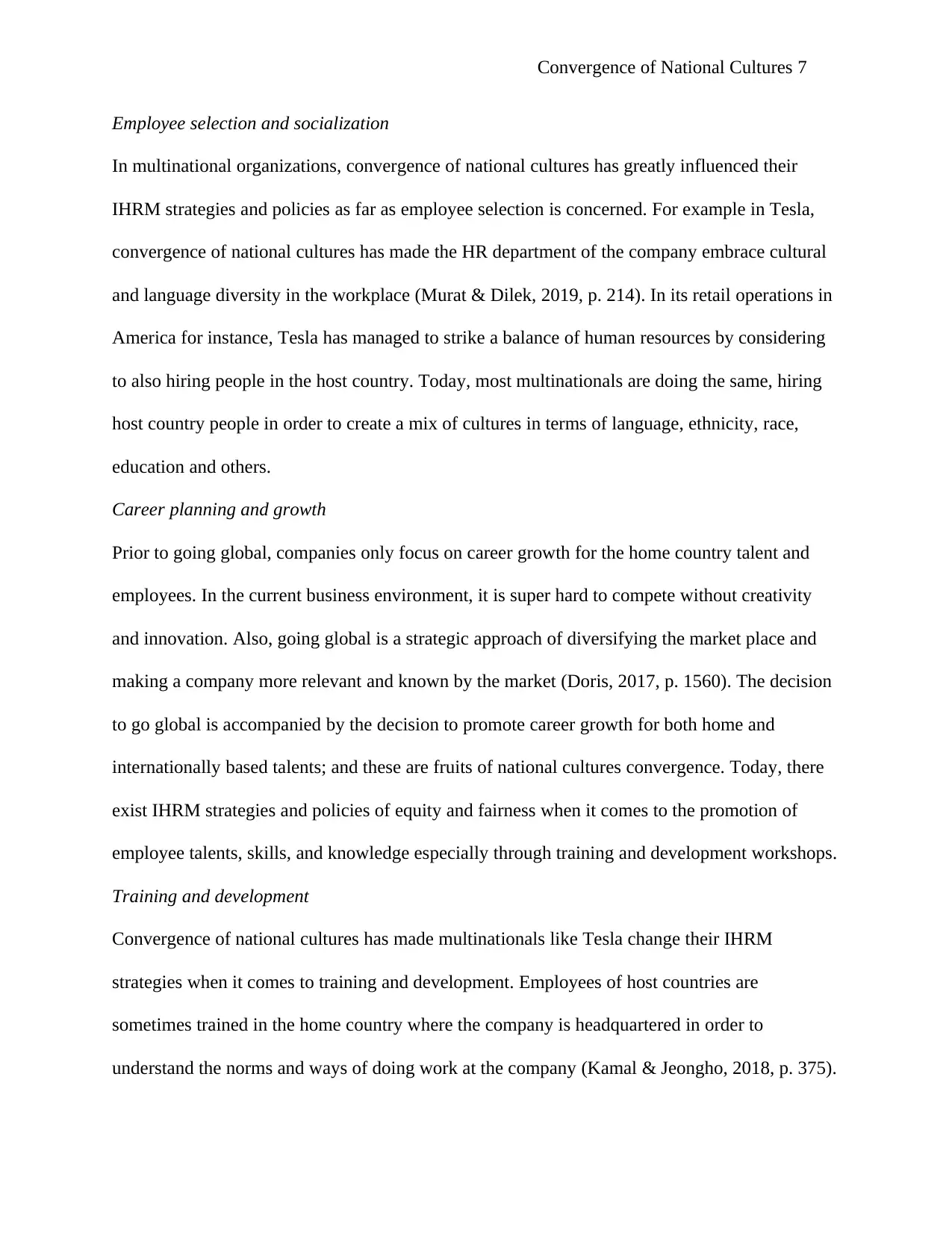
Convergence of National Cultures 7
Employee selection and socialization
In multinational organizations, convergence of national cultures has greatly influenced their
IHRM strategies and policies as far as employee selection is concerned. For example in Tesla,
convergence of national cultures has made the HR department of the company embrace cultural
and language diversity in the workplace (Murat & Dilek, 2019, p. 214). In its retail operations in
America for instance, Tesla has managed to strike a balance of human resources by considering
to also hiring people in the host country. Today, most multinationals are doing the same, hiring
host country people in order to create a mix of cultures in terms of language, ethnicity, race,
education and others.
Career planning and growth
Prior to going global, companies only focus on career growth for the home country talent and
employees. In the current business environment, it is super hard to compete without creativity
and innovation. Also, going global is a strategic approach of diversifying the market place and
making a company more relevant and known by the market (Doris, 2017, p. 1560). The decision
to go global is accompanied by the decision to promote career growth for both home and
internationally based talents; and these are fruits of national cultures convergence. Today, there
exist IHRM strategies and policies of equity and fairness when it comes to the promotion of
employee talents, skills, and knowledge especially through training and development workshops.
Training and development
Convergence of national cultures has made multinationals like Tesla change their IHRM
strategies when it comes to training and development. Employees of host countries are
sometimes trained in the home country where the company is headquartered in order to
understand the norms and ways of doing work at the company (Kamal & Jeongho, 2018, p. 375).
Employee selection and socialization
In multinational organizations, convergence of national cultures has greatly influenced their
IHRM strategies and policies as far as employee selection is concerned. For example in Tesla,
convergence of national cultures has made the HR department of the company embrace cultural
and language diversity in the workplace (Murat & Dilek, 2019, p. 214). In its retail operations in
America for instance, Tesla has managed to strike a balance of human resources by considering
to also hiring people in the host country. Today, most multinationals are doing the same, hiring
host country people in order to create a mix of cultures in terms of language, ethnicity, race,
education and others.
Career planning and growth
Prior to going global, companies only focus on career growth for the home country talent and
employees. In the current business environment, it is super hard to compete without creativity
and innovation. Also, going global is a strategic approach of diversifying the market place and
making a company more relevant and known by the market (Doris, 2017, p. 1560). The decision
to go global is accompanied by the decision to promote career growth for both home and
internationally based talents; and these are fruits of national cultures convergence. Today, there
exist IHRM strategies and policies of equity and fairness when it comes to the promotion of
employee talents, skills, and knowledge especially through training and development workshops.
Training and development
Convergence of national cultures has made multinationals like Tesla change their IHRM
strategies when it comes to training and development. Employees of host countries are
sometimes trained in the home country where the company is headquartered in order to
understand the norms and ways of doing work at the company (Kamal & Jeongho, 2018, p. 375).
Paraphrase This Document
Need a fresh take? Get an instant paraphrase of this document with our AI Paraphraser
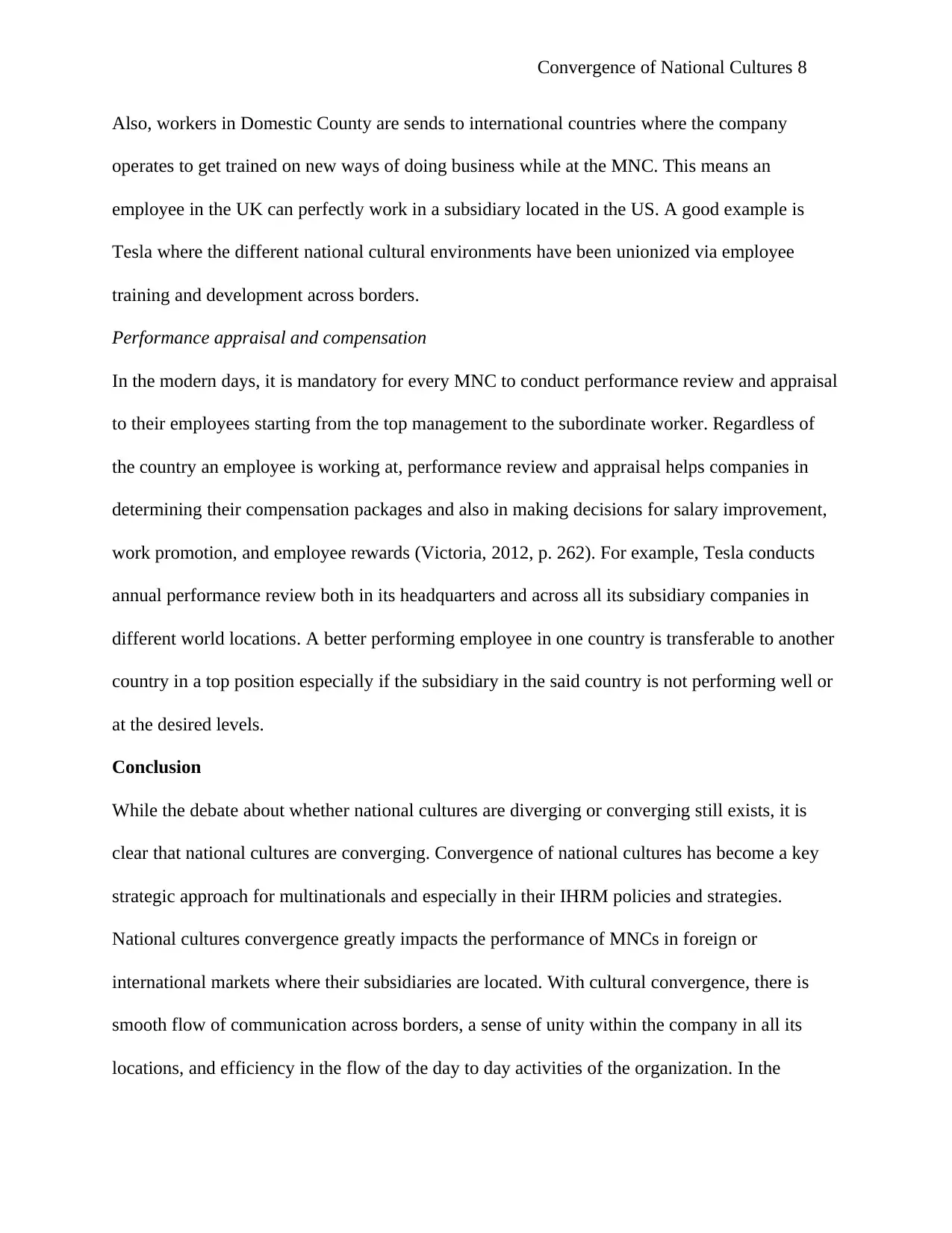
Convergence of National Cultures 8
Also, workers in Domestic County are sends to international countries where the company
operates to get trained on new ways of doing business while at the MNC. This means an
employee in the UK can perfectly work in a subsidiary located in the US. A good example is
Tesla where the different national cultural environments have been unionized via employee
training and development across borders.
Performance appraisal and compensation
In the modern days, it is mandatory for every MNC to conduct performance review and appraisal
to their employees starting from the top management to the subordinate worker. Regardless of
the country an employee is working at, performance review and appraisal helps companies in
determining their compensation packages and also in making decisions for salary improvement,
work promotion, and employee rewards (Victoria, 2012, p. 262). For example, Tesla conducts
annual performance review both in its headquarters and across all its subsidiary companies in
different world locations. A better performing employee in one country is transferable to another
country in a top position especially if the subsidiary in the said country is not performing well or
at the desired levels.
Conclusion
While the debate about whether national cultures are diverging or converging still exists, it is
clear that national cultures are converging. Convergence of national cultures has become a key
strategic approach for multinationals and especially in their IHRM policies and strategies.
National cultures convergence greatly impacts the performance of MNCs in foreign or
international markets where their subsidiaries are located. With cultural convergence, there is
smooth flow of communication across borders, a sense of unity within the company in all its
locations, and efficiency in the flow of the day to day activities of the organization. In the
Also, workers in Domestic County are sends to international countries where the company
operates to get trained on new ways of doing business while at the MNC. This means an
employee in the UK can perfectly work in a subsidiary located in the US. A good example is
Tesla where the different national cultural environments have been unionized via employee
training and development across borders.
Performance appraisal and compensation
In the modern days, it is mandatory for every MNC to conduct performance review and appraisal
to their employees starting from the top management to the subordinate worker. Regardless of
the country an employee is working at, performance review and appraisal helps companies in
determining their compensation packages and also in making decisions for salary improvement,
work promotion, and employee rewards (Victoria, 2012, p. 262). For example, Tesla conducts
annual performance review both in its headquarters and across all its subsidiary companies in
different world locations. A better performing employee in one country is transferable to another
country in a top position especially if the subsidiary in the said country is not performing well or
at the desired levels.
Conclusion
While the debate about whether national cultures are diverging or converging still exists, it is
clear that national cultures are converging. Convergence of national cultures has become a key
strategic approach for multinationals and especially in their IHRM policies and strategies.
National cultures convergence greatly impacts the performance of MNCs in foreign or
international markets where their subsidiaries are located. With cultural convergence, there is
smooth flow of communication across borders, a sense of unity within the company in all its
locations, and efficiency in the flow of the day to day activities of the organization. In the
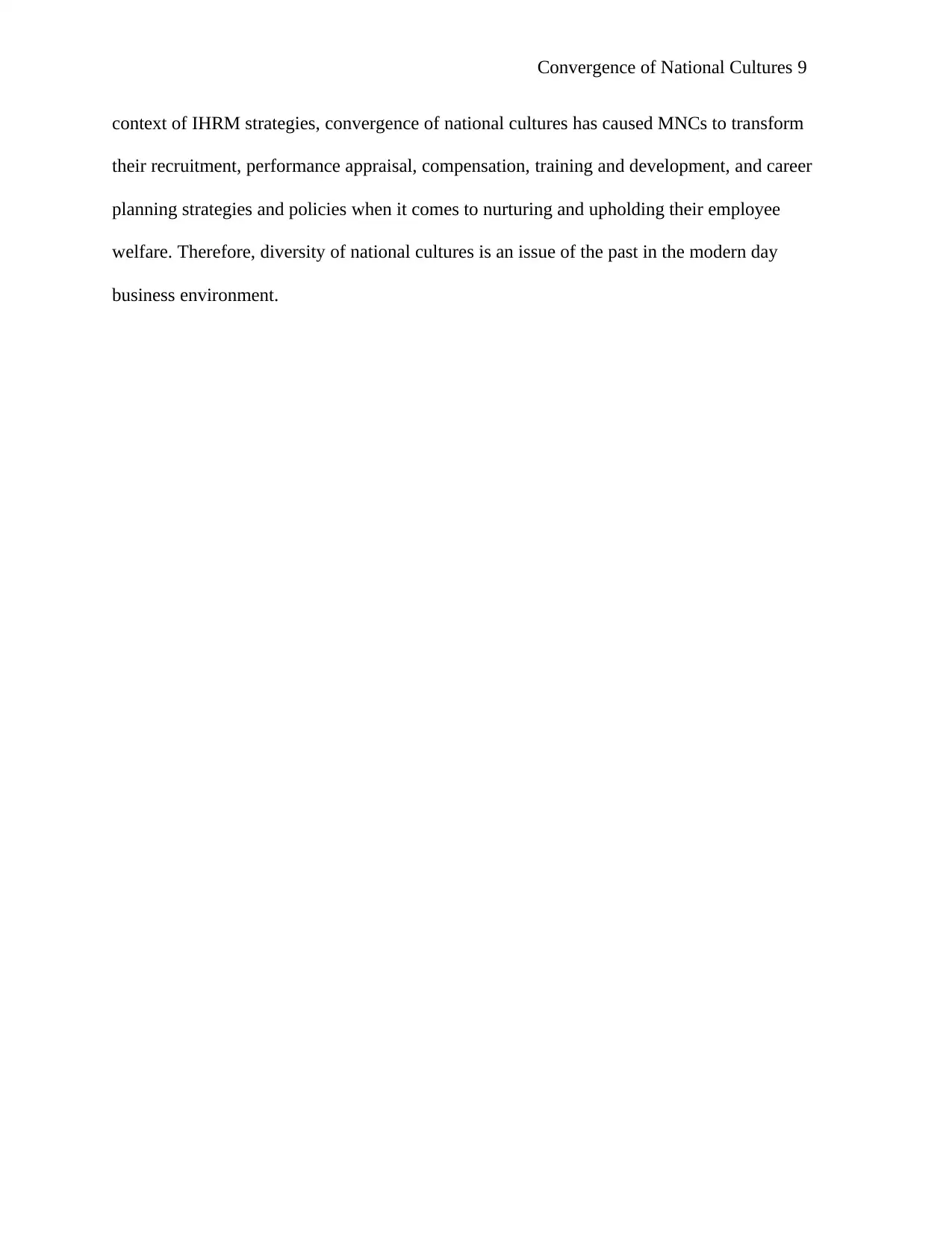
Convergence of National Cultures 9
context of IHRM strategies, convergence of national cultures has caused MNCs to transform
their recruitment, performance appraisal, compensation, training and development, and career
planning strategies and policies when it comes to nurturing and upholding their employee
welfare. Therefore, diversity of national cultures is an issue of the past in the modern day
business environment.
context of IHRM strategies, convergence of national cultures has caused MNCs to transform
their recruitment, performance appraisal, compensation, training and development, and career
planning strategies and policies when it comes to nurturing and upholding their employee
welfare. Therefore, diversity of national cultures is an issue of the past in the modern day
business environment.
⊘ This is a preview!⊘
Do you want full access?
Subscribe today to unlock all pages.

Trusted by 1+ million students worldwide
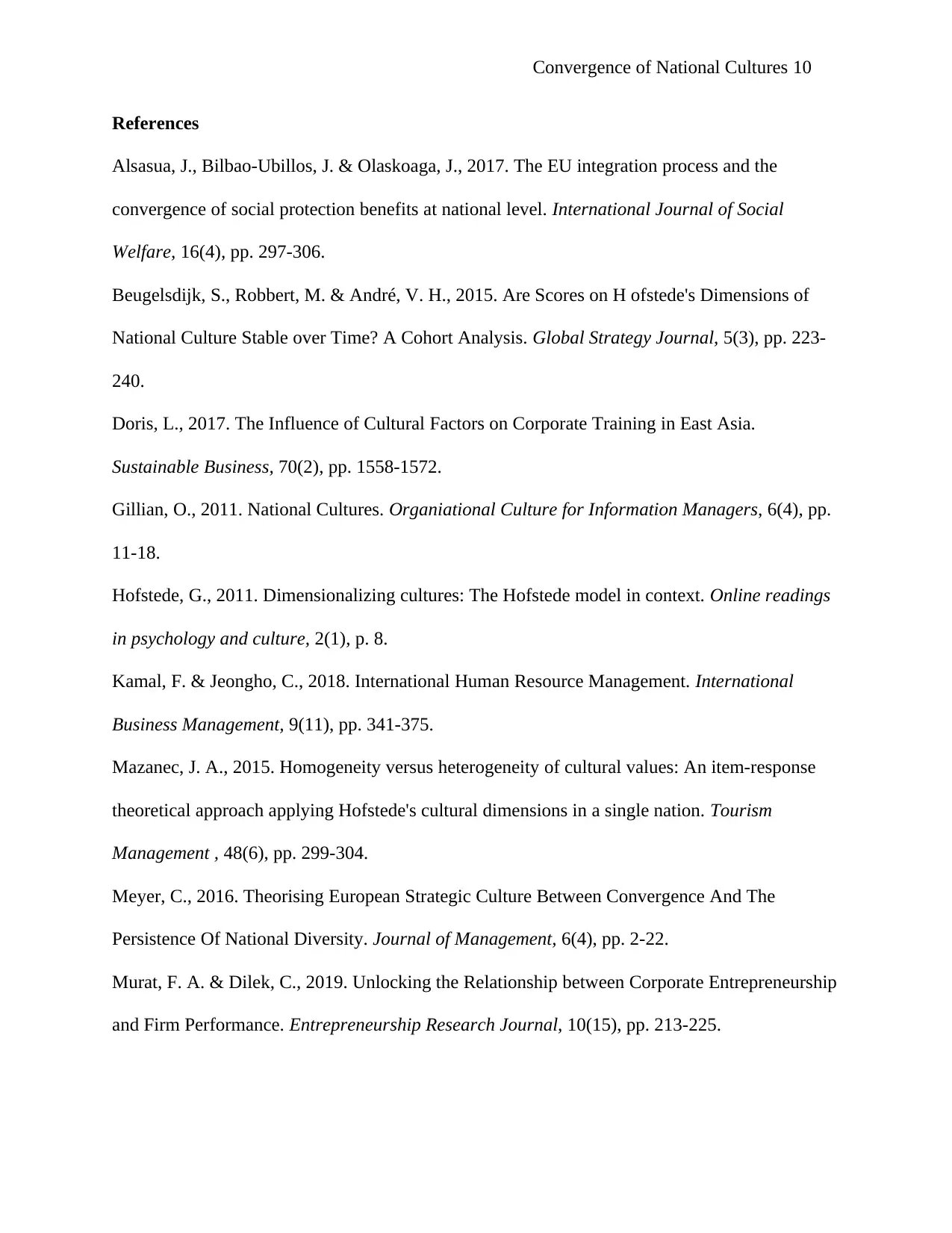
Convergence of National Cultures 10
References
Alsasua, J., Bilbao-Ubillos, J. & Olaskoaga, J., 2017. The EU integration process and the
convergence of social protection benefits at national level. International Journal of Social
Welfare, 16(4), pp. 297-306.
Beugelsdijk, S., Robbert, M. & André, V. H., 2015. Are Scores on H ofstede's Dimensions of
National Culture Stable over Time? A Cohort Analysis. Global Strategy Journal, 5(3), pp. 223-
240.
Doris, L., 2017. The Influence of Cultural Factors on Corporate Training in East Asia.
Sustainable Business, 70(2), pp. 1558-1572.
Gillian, O., 2011. National Cultures. Organiational Culture for Information Managers, 6(4), pp.
11-18.
Hofstede, G., 2011. Dimensionalizing cultures: The Hofstede model in context. Online readings
in psychology and culture, 2(1), p. 8.
Kamal, F. & Jeongho, C., 2018. International Human Resource Management. International
Business Management, 9(11), pp. 341-375.
Mazanec, J. A., 2015. Homogeneity versus heterogeneity of cultural values: An item-response
theoretical approach applying Hofstede's cultural dimensions in a single nation. Tourism
Management , 48(6), pp. 299-304.
Meyer, C., 2016. Theorising European Strategic Culture Between Convergence And The
Persistence Of National Diversity. Journal of Management, 6(4), pp. 2-22.
Murat, F. A. & Dilek, C., 2019. Unlocking the Relationship between Corporate Entrepreneurship
and Firm Performance. Entrepreneurship Research Journal, 10(15), pp. 213-225.
References
Alsasua, J., Bilbao-Ubillos, J. & Olaskoaga, J., 2017. The EU integration process and the
convergence of social protection benefits at national level. International Journal of Social
Welfare, 16(4), pp. 297-306.
Beugelsdijk, S., Robbert, M. & André, V. H., 2015. Are Scores on H ofstede's Dimensions of
National Culture Stable over Time? A Cohort Analysis. Global Strategy Journal, 5(3), pp. 223-
240.
Doris, L., 2017. The Influence of Cultural Factors on Corporate Training in East Asia.
Sustainable Business, 70(2), pp. 1558-1572.
Gillian, O., 2011. National Cultures. Organiational Culture for Information Managers, 6(4), pp.
11-18.
Hofstede, G., 2011. Dimensionalizing cultures: The Hofstede model in context. Online readings
in psychology and culture, 2(1), p. 8.
Kamal, F. & Jeongho, C., 2018. International Human Resource Management. International
Business Management, 9(11), pp. 341-375.
Mazanec, J. A., 2015. Homogeneity versus heterogeneity of cultural values: An item-response
theoretical approach applying Hofstede's cultural dimensions in a single nation. Tourism
Management , 48(6), pp. 299-304.
Meyer, C., 2016. Theorising European Strategic Culture Between Convergence And The
Persistence Of National Diversity. Journal of Management, 6(4), pp. 2-22.
Murat, F. A. & Dilek, C., 2019. Unlocking the Relationship between Corporate Entrepreneurship
and Firm Performance. Entrepreneurship Research Journal, 10(15), pp. 213-225.
Paraphrase This Document
Need a fresh take? Get an instant paraphrase of this document with our AI Paraphraser
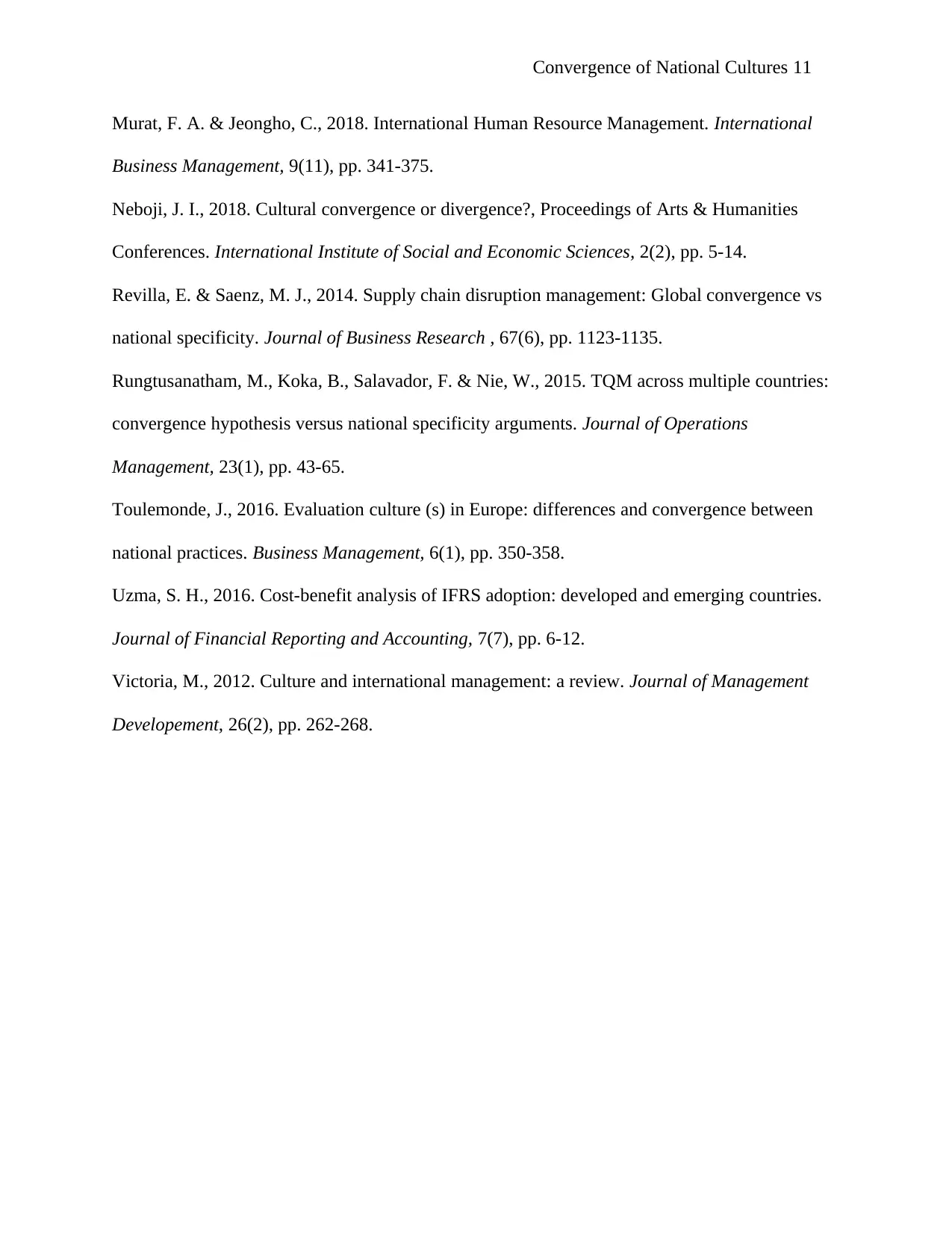
Convergence of National Cultures 11
Murat, F. A. & Jeongho, C., 2018. International Human Resource Management. International
Business Management, 9(11), pp. 341-375.
Neboji, J. I., 2018. Cultural convergence or divergence?, Proceedings of Arts & Humanities
Conferences. International Institute of Social and Economic Sciences, 2(2), pp. 5-14.
Revilla, E. & Saenz, M. J., 2014. Supply chain disruption management: Global convergence vs
national specificity. Journal of Business Research , 67(6), pp. 1123-1135.
Rungtusanatham, M., Koka, B., Salavador, F. & Nie, W., 2015. TQM across multiple countries:
convergence hypothesis versus national specificity arguments. Journal of Operations
Management, 23(1), pp. 43-65.
Toulemonde, J., 2016. Evaluation culture (s) in Europe: differences and convergence between
national practices. Business Management, 6(1), pp. 350-358.
Uzma, S. H., 2016. Cost-benefit analysis of IFRS adoption: developed and emerging countries.
Journal of Financial Reporting and Accounting, 7(7), pp. 6-12.
Victoria, M., 2012. Culture and international management: a review. Journal of Management
Developement, 26(2), pp. 262-268.
Murat, F. A. & Jeongho, C., 2018. International Human Resource Management. International
Business Management, 9(11), pp. 341-375.
Neboji, J. I., 2018. Cultural convergence or divergence?, Proceedings of Arts & Humanities
Conferences. International Institute of Social and Economic Sciences, 2(2), pp. 5-14.
Revilla, E. & Saenz, M. J., 2014. Supply chain disruption management: Global convergence vs
national specificity. Journal of Business Research , 67(6), pp. 1123-1135.
Rungtusanatham, M., Koka, B., Salavador, F. & Nie, W., 2015. TQM across multiple countries:
convergence hypothesis versus national specificity arguments. Journal of Operations
Management, 23(1), pp. 43-65.
Toulemonde, J., 2016. Evaluation culture (s) in Europe: differences and convergence between
national practices. Business Management, 6(1), pp. 350-358.
Uzma, S. H., 2016. Cost-benefit analysis of IFRS adoption: developed and emerging countries.
Journal of Financial Reporting and Accounting, 7(7), pp. 6-12.
Victoria, M., 2012. Culture and international management: a review. Journal of Management
Developement, 26(2), pp. 262-268.
1 out of 11
Related Documents
Your All-in-One AI-Powered Toolkit for Academic Success.
+13062052269
info@desklib.com
Available 24*7 on WhatsApp / Email
![[object Object]](/_next/static/media/star-bottom.7253800d.svg)
Unlock your academic potential
Copyright © 2020–2025 A2Z Services. All Rights Reserved. Developed and managed by ZUCOL.




